
|
Sale 72
February 2-5. 2013
| Hunter - Roman Imperial Coinage |
| |
| |
| Lot |
Photo |
Description |
Realized |
Lot 4124 |
 |
Augustus and Julia, Silver Denarius (3.9g) minted at Rome, 13 BC. Bare head of Augustus, right; behind, lituus. Reverse: Diademed and draped bust of Julia, as Diana, right; at shoulder, quiver. RIC-403; BMCRE-l04. Some marks in the flan. Both portraits are remarkable and this example is certainly one of the finest known. Extremely rare. Extremely Fine.
Julia was the only daughter of Augustus and Scribonia. She was brought up strictly by her father and stepmother Livia. According to the Roman biographer Suetonius, Julia was forbidden to say or do anything, either publicly or privately, that could not decently figure in the imperial day-book. When her father discovered Julia's adulteries, he kept her prisoner on the island of Pandataria for five years, and then moved her to Rhegium in Calabria. Nothing would persuade him to forgive her. Whenever Julia's name came up, Augustus would sigh and quote a line from Homer's Iliad: "Ah, never to have married, and childless to have died!" Ultimately, Julia was allowed to die of malnutrition before the end of AD 14.
Estimated Value $15,000 - 20,000.
Wolfen Family Foundation; Ex Numismatic Fine Arts, early 1970s.
View details and enlarged photos
| Realized
$29,900 |
Lot 4125 |
 |
Augustus, 27 BC-AD 14. Silver Denarius (3.70g) uncertain Eastern mint, ca. 12 BC. CAESAR. Youthful head of Augustus right within an oak wreath. Reverse: Candelabrum ornamented with a ram's head, surmounted by crescent, all within floral wreath entwined with two bucrania and two paterae. RIC 540; Cohen 2; RSC 2 (Caius Caesar). Deep iridescent toning over a few old hairlines. Struck with a fine, high relief portrait. Rare. Nearly Extremely Fine.
This enigmatic issue has often been assigned to 17 BC and seen as a commemorative of the Ludi Saeculares, while the portrait was long believed to be that of Caius Caesar. Noted Augustus scholar and collector Richard Prideaux has argued cogently for a different view. The youthful portrait here can only be that of Augustus as signaled by the oak wreath, his personal signature. The overall symbolism, meanwhile is not only religious but funereal, and the only logical event of magnitude that would call for such an issue was the sudden death of Agrippa in 12 BC from a fatal illness suffered from the rigors of the Pannonian campaign.
Marcus Vipsanius Agrippa and his family had been made official heirs of the empire only scant months before. His demise deeply saddened Rome and especially affected the legions who revered Agrippa. Prideaux has proposed that this issue, and its gold counterpart, was struck in Pannonia to pay the now leaderless and possibly restive legions. A local engraver would have produced the dies. Unfamiliar with producing the face of Augustus, he used a generic profile but identified it as Augustus by using the oak wreath. Thus also reminding the legions of their emperor's corona civica while paying tribute to their beloved departed commander.
Estimated Value $4,000 - 6,000.
The Hunter Collection.
View details and enlarged photos
| Realized
$5,060 |
Lot 4126 |
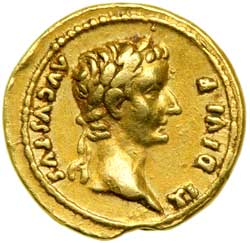 |
Tiberius, AD 14-37. Gold Quinarius (3.94g). Struck at Lugdunum (Lyon), AD 15-16. TI DIVI F AVGVSTVS. Laureate head of Tiberius facing right. Reverse: TR POT XVII. Victory seated right on globe, holding wreath. RIC 5; Cohen 49; Giard 117, 125c (this specimen); BMC 12. Well struck and delicately toned. Rare. Choice Very Fine.
Estimated Value $3,500 - 4,000.
Ex Bank Leu 13, April 1975 Zurich, lot 390.
View details and enlarged photos
| Realized
$3,795 |
Lot 4127 |
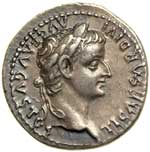 |
Tiberius, 14-37 AD. Silver Denarius (3.6g) minted at Lugdunum. Laureate head of Tiberius, right. Reverse: Female (Livia?) seated right, holding branch and scepter. RIC-25; BMCRE-30. Toned. Extremely Fine.
Estimated Value $1,000 - 1,300.
The Wolfen Family Foundation Collection; Ex Numismatic Fine Arts, early 1970s.
View details and enlarged photos
| Realized
$1,495 |
Lot 4128 |
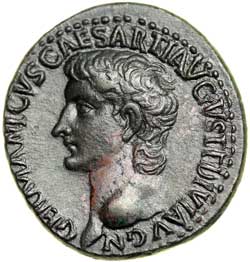 |
Germanicus, adopted son of Tiberius, father of Caligula. AE As (12g) minted at Rome, AD 37-38. Struck under Caligula. GERMANICVS CAESAR TI AVGVST F DIVI AVG N. Bare head of Germanicus, left. Reverse: C CAESAR AVG GERMANICVS PON M TR POT around large S C. RIC (Gaius) 35; BMCRE 49; CBN 73. Of exceptional style. Dark brown patina with some reddish highlights. A wonderful bold portrait. Extremely Fine.
Germanicus, father of Caligula (Gaius Caesar), was born in 15 BC, the son of Nero Claudius Drusus and Antonia the Younger, and was adopted by his paternal uncle Tiberius in AD 4. During his lifetime, Germanicus was much admired and garnered a reputation for tolerance and leniency, even toward his detractors. Suetonius ("Life of Gaius Caligula") says that Germanicus "had won such intense popular devotion that he was in danger of being mobbed to death whenever he arrived at Rome or took his leave again." Before Germanicus was of age, he was appointed Consul, and at the death of Augustus, the Senate appointed him to command the forces in Germany. Though the legions there were unanimously opposed to Tiberius' succession and would have acclaimed Germanicus Emperor, he showed a remarkable example of filial respect and personal integrity by diverting their attention from this project; he took the offensive in Germany and won a triumph. He was so deeply respected and loved by all his acquaintances that Augustus, according to Suetonius ("Life of Gaius Caligula"), wondered for a long time whether to make Germanicus his successor, though ultimately ordered Tiberius to adopt him. (Since Tiberius had himself been adopted by Augustus, Germanicus was thus a member of the Julio-Claudian clan, standing in direct line of succession). According to Suetonius ("Life of Tiberius"), it was believed that, ultimately, Tiberius had arranged for the poisoning of Germanicus. "Give us back Germanicus!" was shouted all night and scrawled on walls throughout Rome after it was widely suspected that Tiberius had forced Gnaeaus Piso, the governor of Syria, to carry out the evil deed. Everyone believed, and with good reason, that moral respect among the Romans for Germanicus had alone kept Tiberius from displaying the cruelty of his wicked heart. (Suetonius, The Twelve Caesars, trans. by Robert Graves).
Estimated Value $4,000 - 5,000.
Ex Numismatica Ars Classica 62, lot 2019.
View details and enlarged photos
| Unsold |
Lot 4129 |
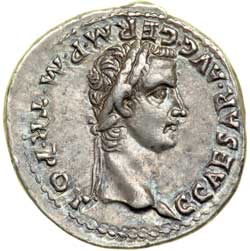 |
Caligula and Germanicus. Silver Denarius (3.78 g) minted at Lugdunum (Lyon), AD 37. Laureate head of Caligula right. Reverse: Bare head of Germanicus right. RIC 18; RSC 4; BMCRE 19. Bold portraits with lovely grayish-violet and light blue iridescent toning. Rare. A remarkable example. Rare. Extremely Fine.
Estimated Value $10,000 - 12,000.
View details and enlarged photos
| Realized
$18,975 |
Lot 4130 |
 |
Claudius, AD 41-54. Gold Aureus (7.7g) minted at Rome, AD 44-45. Laureate head of Claudius right. Reverse: Pax-Nemesis advancing right, pointing winged caduceus at serpent before, and holding out fold of drapery with her other hand. RIC 27; Calicó 366; Cohen 55. Strong types, well-centered, of pleasing style. Wonderful portrait. Extremely Fine.
This superb aureus of Claudius minted in AD 44/5 features on the reverse an elegant winged figure of the goddess Nemesis with a snake at her feet. Nemesis was associated with the concept of righteous retribution. As the type occurs regularly on the precious metal coinage of this reign, it was clearly intended to symbolize a fundamental aspect of the emperor's personal policy. Doubtless, it was this idea that was invoked as a justification for the invasion and conquest of Britain commencing in AD 43 and perhaps also for the execution of his wife Messalina half a decade later.
Estimated Value $15,000 - 20,000.
The Hunter Collection.
View details and enlarged photos
| Realized
$37,950 |
Lot 4131 |
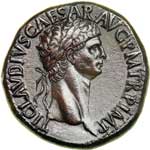 |
Claudius, AD 41-54. AE Sestertius (28.1g) minted at Rome, AD 41-42. TI CLAVDIVS CAESAR AVG P M TR P IMP. Laureate head right of Claudius. Reverse: EX S C / OB / CIVES / SERVATOS in four lines within oak wreath; dotted border. Sear 1849; RIC 96; Giard 152. The fine dark brown patina lightly smoothed in the fields. Superb portrait in high relief. Extremely Fine.
Estimated Value $7,000 - 9,000.
The Hunter Collection; Ex Numismatica Ars Classica 7 (Zurich), 2-3 March 1994, Lot 684.
View details and enlarged photos
| Realized
$6,038 |
Lot 4132 |
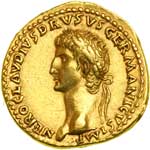 |
Nero Claudius Drusus, father of both Germanicus and Claudius. Gold Aureus (7.8g) minted at Lugdunum, AD 41-42. NERO CLAVDIVS DRVSVS GERMANICVS IMP. Laureate head of Nero Claudius Drusus left. Reverse: DE GE-R-MA-NIS. Two oblong shields crossed in front of two pairs of crossed spears and vexillum flanked by trumpets. Sear 1893; Calicó 317; RIC 73; Giard 7; BMC 105 (this coin). A marvelous example and very rare. Extremely Fine.
Nero Claudius Drusus, also known as Drusus Senior, was the younger brother of the emperor Tiberius. Born in 38 BC, he was brought up in the household of Augustus and later married Antonia, the daughter of Mark Antony and Augustus' sister Octavia. The couple had two sons, Germanicus and the future emperor Claudius. Drusus was a brilliant general, and in 12 BC Augustus entrusted him with the overall command of the projected conquest of Germany. Unfortunately, tragedy struck in 9 BC when the twenty-nine-year-old general expired in summer encampment following a fall from his horse. He was succeeded in the German command by his brother Tiberius. No coinage was issued in the name of Nero Claudius Drusus until half a century after his death. On the accession to the throne of his younger son Claudius, a commemorative coinage was instituted by the new emperor honoring both his father and his mother, the latter only recently deceased at the age of seventy-three. These were struck in gold, silver, and orichalcum, and the precious metal denominations of Drusus celebrate his victories in Germany (DE GERMANIS). This beautiful aureus type shows an arrangement of arms together with a legionary vexillum.
Estimated Value $20,000 - 25,000.
The Hunter Collection.
View details and enlarged photos
| Realized
$44,850 |
Lot 4133 |
 |
Nero Claudius Drusus, father of both Germanicus and Claudius. AE Sestertius (25.9g) minted at Rome by Claudius, AD 42-43. NERO CLAVDIVS DRVSVS GERMANICVS IMP. Bare head of Nero Claudius Drusus left. Reverse: TI CLAVDIVS CAESAR AVG P M TR P IMP S C. Claudius seated left on a curule chair, holding a branch and roll; globe below, with weapons and armor around. RIC (Claudius) 93. Bold details, marvelous olive-brown and green patina. A splendid example that ranks among the finest known. Extremely Fine.
Estimated Value $15,000 - 20,000.
The Hunter Collection; Ex Superior Stamp & Coin NYINC Sale, December 8-9, 1995, lot 882.
View details and enlarged photos
| Realized
$23,000 |
Lot 4134 |
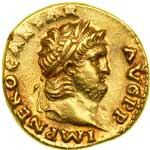 |
Nero, AD 54-68. Gold Aureus (7.3g) minted at Rome, AD 65-66. IMP NERO CAESAR AVG P P. Laureate and bearded head right of Nero. Reverse: [IVP] PITER CVSTOS. Half-draped Jupiter seated left, holding thunderbolt in right hand, scepter in left. Calicó 414; RIC 47; cf. Sear 1930 (obverse legend). Some fine hairlines on the reverse from old cleaning noted. Underlying luster with rose colored toning. Outstanding portrait. About Extremely Fine.
Estimated Value $5,000 - 7,000.
The Hunter Collection; from the Boscoreale hoard of 1895.
View details and enlarged photos
| Realized
$8,338 |
Lot 4135 |
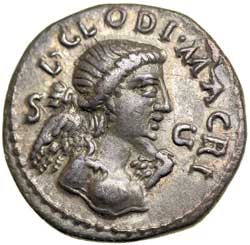 |
Clodius Macer, AD 68. Silver Denarius (3.1g). Struck at Carthage May-September AD 68 Usurper in Africa. L. CLODI MACRI. Draped bust of Victory right; at sides, S C. Reverse: Legionary eagle between two vexilla; in field below, above exergual line, LEG - III. RIC 17; Hewitt 26-27 (same dies); RSC 4a. Almost invisible marks under medium gray toning. Extremely rare. Only four examples were know to Hewitt, three of which were in museums. Choice Very Fine.
Coins of Clodius Macer are not only among the rarest of all Roman silver coins, they are also important historical documents which throw light on an otherwise obscure period of Roman history. Little is known about the early career of Lucius Clodius Macer, but by AD 68 he had been appointed by Nero as provincial governor of North Africa. By April of AD 68, Nero's corrupt regime was collapsing and the governors Vindex in Gaul and Galba in Spain were in open revolt. As chaos gripped the Empire, Macer threw in his lot with the rebels and threatened to cut off the African grain supply to Rome. Initially, he had declared his support for the Roman Senate, but following Nero's suicide, Macer abandoned his idealistic pose and began plotting to seize power himself. Galba, who had been proclaimed emperor by the Senate, attempted to win over Macer, but the latter refused to recognize the new ruler and instead struck new coins identifying himself as "pro-praetor of Africa." When Macer began raising two new legions, Galba issued a warrant for his arrest and execution, an order carried out by loyalist officers in Macer's army. His coinage was immediately recalled and melted down, accounting for its extreme rarity today.
Macer controlled the Legio III Augusta in Numidia and used it to take over Carthage, where this coin was presumably struck. The obverse type commemorates this 'Victory,' while the letters S C, "Senatus Consulto," were a nod to the authority of the Roman Senate, an inscription that had not been used on Roman silver coins since around 40 BC. The reverse type is modeled on the well-known legionary coinage of Marc Antony and suggests the coin was specifically struck to pay Macer's troops.
Estimated Value $30,000 - 35,000.
Ex Numismatica Ars Classica 62, lot 2024; Ex Classical Numismatic Group sale 72, 2006, lot 1404.
View details and enlarged photos
| Unsold |
Lot 4136 |
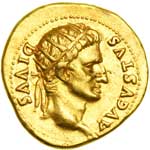 |
Galba, AD 68-69. In the name of Divus Augustus, 27 BC - AD 14. Gold Aureus (7.2g). Minted at Tarraco, AD 68. DIVVS AVGVSTVS. Radiate head right of the deified Augustus, his features resembling those of Galba. Reverse: HISPANI - A. Hispania standing left, holding two grain-ears in right hand, two short spears in left; shield slung on her back. Sear 2068; Calicó 451a (this coin); RIC 112; Giard 63. Lustrous. Exceedingly rare. One of perhaps six known examples. About Extremely Fine.
The closing months of Nero's reign saw uprisings against his tyrannical rule in Gaul, Spain, and North Africa. Julius Vindex in Gallia Lugdunensis was the first of these commanders (March AD 68), and his appeal for military assistance was answered the following month by Servius Sulpicius Galba, governor of Hispania Tarraconensis. Vindex issued anonymous aurei and denarii, probably at Vienne, until his revolt was crushed by Verginius Rufus, governor of Upper Germany, in May. Galba was now committed to the cause, and Nero's suicide in June and the Senate's subsequent acceptance of his rule left Galba as the successor to the now extinct Julio-Claudian dynasty. While Galba was in revolt in Spain he also issued anonymous aurei and denarii as well as some with his portrait and the title Imperator.
This aureus was issued at Tarraco in the period April-June AD 68 and bears the head of the Empire's founder as the deified Augustus. At this time of civil war, the type looks back to the stability of the Augustan age and forward to its restoration under a new regime. The personification of Hispania on the reverse honors the province from which Galba's bid for the throne was being launched.
Estimated Value $30,000 - 40,000.
The Hunter Collection; Ex Gilbert Steinberg Collection (Numismatica Ars Classica and Spink Taisei, 16 November 1994, lot 261); Leu Auction 52, 15 May 1991, lot 170.
View details and enlarged photos
| Realized
$100,625 |
Lot 4137 |
 |
Galba, AD 68-69. AE Sestertius (26.6g) minted at Rome, June-August AD 68. IMP SER GALBA AVG TR P. Laureate and draped bust of Galba right. Reverse: ROMA in exergue; S C. Roma seated left, holding a spear and resting her arm on a shield set on a rock. RIC 243; Cohen 171. Rich deep forest-green patina. Pleasing style and high relief portrait. Extremely Fine.
Estimated Value $10,000 - 15,000.
The Hunter Collection; Ex Superior Stamp & Coin, NYINC Auction, December 8-9, 1995, lot 886; Peus 338, Lot 591.
View details and enlarged photos
| Unsold |
Lot 4138 |
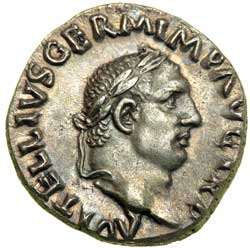 |
Vitellius, AD 69. Silver Denarius (3.3g) minted at Rome, July-December AD 69. Laureate head of Vitellius right. Reverse: Concordia (Harmony) seated left holding patera and cornucopiae. Lightly toned and beautiful style. Very scarce, particularly so in such a high grade. Extremely Fine.
Estimated Value $5,000 - 6,000.
Ex Classical Numismatic Group, Sale 60, May 22, 2002, lot 156; Jürgen K. Schmidt Collection, Leu Numismatik Auktion 72, May 12, 1998, lot 420.
View details and enlarged photos
| Unsold |
Lot 4139 |
 |
Vitellius, AD 69. AE Dupondius (13.95g) minted at Rome, September-October AD 69. A VITELLIVS GERMAN IMP AVG P M TR P. Laureate head right of Vitellius. Reverse: PAX AVGVSTI. Pax (Peace) standing left, holding olive branch in right hand, cornucopiae in left; in fields, S C. Sear 2211; RIC 146. Glossy uniform reddish-brown patina. A magnificent example of fine portrait engraving in high relief. Absolutely superb and possibly the finest known bronze of Vitellius. Nearly Mint State.
Estimated Value $15,000 - 20,000.
The Hunter Collection; Ex Antiqua II, 1975, Lot 33; Numismatica Ars Classica The Gil Steinberg Collection, 16 Nov. 1994, lot 279; Ex Leu 18, 1977, Lot 307.
View details and enlarged photos
| Realized
$86,250 |
Lot 4140 |
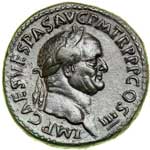 |
Vespasian, AD 69-79 AD. AE Sestertius (33.5g) minted at Rome, AD 71. IMP CAES VESPAS AVG P M TR P PP COS III. Laureate head right of Vespasian. Reverse: IVDAEA CAPTA. Palm tree; to left, bound male captive standing right; to right, Judaea seated right, in mourning; to left and right on groundline, arms; in exergue, S C. RIC 424; cf. Sear 2325 (obverse legend). Uniform dark brown patina. Extremely Fine.
This celebrated type is part of the large series issued by Vespasian early in his reign (mostly in AD 71) celebrating the quelling of the Jewish uprising known as the "First Revolt" or the "Jewish War." When Vespasian left the East to make his bid for the imperial throne, he left his elder son Titus in charge of the military operations in Judaea. Jerusalem was captured in September AD 70, and the following year father and son staged a magnificent triumph through the streets of Rome. The event was commemorated by the Arch of Titus which was erected early in the reign of Vespasian's younger son, Domitian, and still stands today near the ruins of the Roman Forum.
Estimated Value $20,000 - 25,000.
The Hunter Collection.
View details and enlarged photos
| Realized
$18,400 |
Lot 4141 |
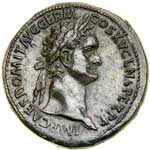 |
Domitian, AD 81-96. AE Sestertius (28.2g) minted at Rome, AD 90-91. IMP CAES DOMIT AVG GERM COS XV CENS PER P P. Laureate head right of Domitian. Reverse: IOVI VICTORI. Half-draped Jupiter seated left, holding Victory on outstretched right hand, scepter in left; in exergue, S C. Sear 2766; RIC 388. Well struck on a medallic flan. Lovely greenish-brown patina with reddish highlights. Extremely Fine.
Estimated Value $10,000 - 13,000.
The Hunter Collection; Ex Superior Stamp & Coin NYINC, Dec. 8-9, 1995, lot 898; Numismatica Ars Classica 8, 3rd April 1995, lot 802.
View details and enlarged photos
| Realized
$28,750 |
Lot 4142 |
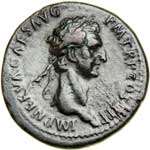 |
Nerva, AD 96-98 AD. AE Sestertius (25g) minted at Rome, AD 97. IMP NERVA CAES AVG P M TR P COS III P P. Laureate head right of Nerva. Reverse: FISCI IVDAICI CALVMNIA SVBLATA. Palm tree dividing S C. Sear 3044; RIC 82; Giard 97. Glossy chocolate brown patina. Choice Very Fine.
During the course of his short reign, the lawyer-emperor Nerva undertook measures to correct the abuses in the collection of the Fiscus Iudaicus (Jewish Tax). The half-shekel Temple Tax had been obligatory under Jewish law for free adult Jewish males as long as the Jewish Temple in Jerusalem was standing. When the Jewish Temple was destroyed in AD 70 after the quelling of the "First Revolt," the Tax continued to be levied on the Jews, but it was paid, instead, to the temple of Capitoline Jupiter. This Tax became known as the Fiscus Iudaicus. When a fire in AD 80 destroyed the temple of Capitoline Jupiter, Domitian's administrators of the Fiscus Iudaicus sought out both practicing Jews as well as those who had renounced Judaism (or practiced it secretly to evade the tax) in order to garner more funds. The Calumnia, or harshness, with which the administrators ascertained who was Jewish is described by Suetonius ("Life of Domitian"), who recalls how he himself was present when the procurator with a large group of assessors examined an old man of ninety to see whether the man had been circumcised. Within the first year of his reign, Nerva put an end to this Calumnia, i.e., the insulting way the administrators ascertained who Jewish. The effect of "The Insult of the Jewish Tax Removed" was that, thenceforward, only openly pacticing Jews were liable to pay the Jewish Tax, and no one had to undergo a public investigation as to wheher or not he were circumcised. The inscription surrounding the palm tree proclaims "The Insult of the Jewish Tax Removed." However, the tax itself was left on the statute books and appears to have remained in effect until its abolition by the emperor Julian (AD 36-363).
Estimated Value $5,000 - 6,000.
The Hunter Collection; Ex August Voirol Collection (Münzen und Medaillen 38, 6-7 December 1968, lot 407).
View details and enlarged photos
| Realized
$6,900 |
Lot 4143 |
|
Withdrawn
| Unsold |
Lot 4144 |
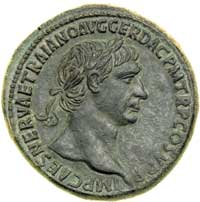 |
Trajan, AD 98-117. AE Sestertius (25.8g) minted at Rome, AD 104-106. IMP CAES NERVAE TRAIANO AVG GER DAC P M TR P COS V P P. Laureate head of Trajan right. Reverse: SPQR OPTIMO PRINCIPI S C. General view of the Circus Maximus, as seen from the Forum Boarium: porticos with two entrances, with monumental gate crowned by quadriga, triumphal arches, curved wall, temple of Sol, spina with obelisk flanked by equestrian statue of Trajan and shrine of Cybele in background. RIC 571; BMC 853; Cohen 546; Hirmer pl. 76, 267.
Very rare and recognized as the finest known specimen. Lovely untouched apple-green patina, complimented by a large and flawless flan perfectly struck from new dies of very neat execution. Superb Extremely Fine.
The Circus Maximus, Rome's great chariot-racing arena adjoining the Palatine Hill, dates back to the fourth century BC. The wooden seating surrounding the track was frequently consumed by fire during the Julio-Claudian and Flavian periods, and Trajan undertook a major restoration of the structure early in the second century AD. This was commemorated on the coinage, thus providing the first detailed representation of the building. The great central obelisk is clearly visible as are various other details of the interior. Brought from Heliopolis in Egypt by Augustus, this obelisk of Rameses II now stands in the middle of Rome's Piazza del Popolo. A similar view appears on coins of Caracalla issued in AD 213 following a further restoration. Constantine the Great undertook the final refurbishment of the building and the last recorded event in the Circus took place under the Ostrogothic king Totila in AD 550 (cf. Hill, The Monuments of Ancient Rome as Coin Types, pp. 47-8). The restoration of the Circus Maximus in AD 103 was commemorated by Trajan on sestertii from AD 104 thru 106. Although the type itself is not extremely rare, this popular type is seldom found in such choice condition.
Estimated Value $25,000 - 35,000.
The Hunter Collection; Ex Superior Stamp & Coin, NYINC Auction, December 8-9, 1995, lot 908; Numismatica Ars Classica 8, lot 723.
View details and enlarged photos
| Realized
$71,875 |
Lot 4145 |
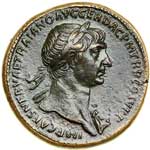 |
Trajan, AD 98-117. AE Sestertius (26g) minted at Rome, AD 105. IMP CAES NERVAE TRAIANO AVG GER DAC P M TR P COS V P P. Laureate bust right of Trajan, left shoulder draped. Reverse: S P Q R OPTIMO PRINCIPI. Arched single-span bridge over river, with covered walkway and gateways at either end surmounted by three statues; entrance to right approached by flight of stairs; below, boat moored near right bank, secured by anchor; below waterline, S C. Sear 3207; RIC 569. Dark brown patina with lighter highlights. Well detailed and struck in high relief. Nearly Extremely Fine.
The precise identity of the bridge depicted on this handsome sestertius remains a subject of scholarly speculation. Traditionally, it has been described as the bridge over the Danube near Drobetae, designed by the architect Apollodorus of Damascus and built in AD 104 as part of the preparations for Trajan's Second Dacian War. However, the totally different appearance of this bridge on Trajan's Column in Rome casts serious doubt on this identification. An attractive alternative is provided by the Pons Sublicius in Rome's Regio XIV, the first bridge to span the Tiber. A wooden structure, the bridge was frequently damaged or swept away by floods but was always restored or rebuilt in wood as a matter of religious practice. Doubtless, such a restoration occurred early in the reign of Trajan and was commemorated by this coin type, which appears also on dupondii and asses.
Estimated Value $6,000 - 7,000.
The Hunter Collection.
View details and enlarged photos
| Unsold |
Lot 4146 |
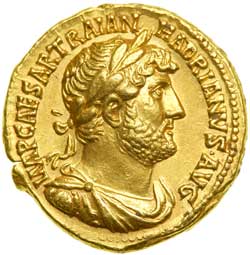 |
Hadrian, AD 117-138. Gold Aureus (7.3g). Mint of Rome AD 122. Bust of Hadrian, laureate, draped and cuirassed, right. Reverse: Mars standing facing, holding spear and shield. RIC 65; Calico 1312; Sear 3407. Boldly struck and fully lustrous. A superb example. Nearly Mint State.
Estimated Value $15,000 - 18,000.
View details and enlarged photos
| Realized
$18,400 |
Lot 4147 |
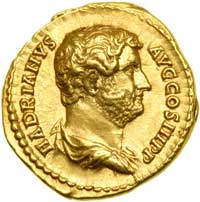 |
Hadrian, AD 117-138. Gold Aureus (7.2g) minted at Rome, ca. AD 134-138. HADRIANVS AVG COS III PP. Bare-headed and draped bust of Hadrian right. Reverse: FORTVN-A AVG. Fortuna (Fortune) standing left, holding patera in outstretched hand and cornucopiae. RIC 245. Bold, beautiful high relief portraiture of fine style. Lustrous. Extremely Fine.
Estimated Value $10,000 - 14,000.
The Hunter Collection.
View details and enlarged photos
| Realized
$13,800 |
Lot 4148 |
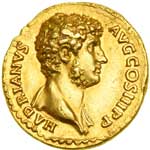 |
Hadrian, with Trajan and Plotina, AD 117-138. Gold Aureus (7.2g) minted at Rome, ca. AD 134-138. HADRIANVS AVG COS III P P. Bare-headed, bust right of bearded Hadrian, left shoulder draped. Reverse: DIVIS PAREN - TI - BUS. Bare-headed, draped bust right of Trajan facing diademed, draped bust of Plotina; each with a star above. Calicó 1417; RIC 232B; Hirmer 290. Delicately toned. Extremely rare. Fabulous portraits of Hadrian, Trajan and Plotina, all struck in high relief. An incredible coin of great historical and artistic merit. Lustrous. Superb Extremely Fine.
The remarkable series of seven aureus types to which this coin belongs was issued in the opening weeks of the reign of Antoninus Pius. They were first identified as a homogeneous group by Philip Hill in 1970. Although they revive obverse types from three different phases of Hadrian's reign, all are characterized by the youthful appearance of the portraiture that is clearly intended to idealize the late emperor's features and to emphasize his worthiness to be counted among the Divi, or Imperial gods. The series is best attributed to the period of dispute been the Senate and the new emperor over the deification of Hadrian and the ratification of his acts. Hadrian had never been on good terms with the Roman senators, and they were ill-disposed to honor him following his death. Antoninus' purpose was to eulogize the virtues of his predecessor and adoptive father and to represent him as the chosen successor of the highly revered Trajan and the favorite of the equally popular empress Plotina. Realizing that Antoninus was quite prepared to abdicate over the issue, the Senate bowed to the emperor's will, and Hadrian was duly deified. Antoninus' filial loyalty was respected by the conscript fathers and, in recognition, he received the name "Pius" that appears on all his subsequent coinage, eventually to become a dynastic title.
Estimated Value $50,000 - 60,000.
The Hunter Collection; Ex Leu 48, 10 May 1989, lot 351; Leu 2, 1972, lot 389.
View details and enlarged photos
| Realized
$66,125 |
Lot 4149 |
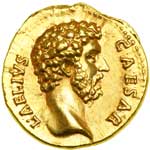 |
Aelius, Caesar under Hadrian, AD 136-138. Gold Aureus (7.2g), minted at Rome, AD 137. L AELIVS CAESAR. Bare head right of bearded Aelius. Reverse: CONCORD in exergue; TRIB POT COS II around. Concordia (Harmony) enthroned left, holding patera in outstretched right hand, resting left on cornucopiae. Sear 3962; Calicó 1444; RIC 443. A marvelous portrait struck in high relief. Very rare. Lustrous. Superb Extremely Fine.
In AD 136 the emperor Hadrian, realizing that his health was beginning to fail, adopted Lucius Ceionius Commodus as heir to the throne and bestowed on him the official name of Lucius Aelius Caesar. In order to gain administrative and military experience he was sent to govern the two Pannonias, and on January 1, AD 137, he entered upon his second consulship. However, fate decreed that he was never to be called upon to prove his abilities to govern a vast empire, as he died of a massive hemorrhage on New Year's Day, AD 138, thus predeceasing the emperor by more than six months. It is unclear why Hadrian should have regarded Aelius as a suitable candidate for the succession. The Caesar suffered from tuberculosis, a condition that was aggravated by his addiction to a self-indulgent lifestyle, and it is unlikely that his reign would have been of long duration.
Estimated Value $25,000 - 30,000.
The Hunter Collection; Ex Michael F. Price Collection (Stacks, December 3, 1996, lot 186); Ex McLendon Collection (Christie's New York, June 12, 1993, lot 130); Numismatic Fine Arts XII, March 23-24, 1983; Metropolitan Museum of Art, Durkee (Sotheby's November 1972, lot 88).
View details and enlarged photos
| Realized
$71,875 |
Lot 4150 |
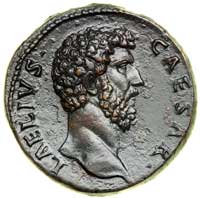 |
Aelius, Caesar under Hadrian, AD 136-138. AE Sestertius minted at Rome, AD 137. L AELIVS CAESAR. Bare head of bearded Aelius right. Reverse: CONCORD in exergue; TR POT COS II S C. Concordia (Concord) seated left, holding patera in outstretched right hand and resting left arm on cornucopiae. Sear 3979; RIC 1057; Cohen 7. Attractive glossy olive-brown. Nice and bold with a masterful depiction of Aelius in high relief. Extremely Fine/Very Fine.
Estimated Value $5,000 - 6,000.
The Hunter Collection.
View details and enlarged photos
| Realized
$18,975 |
Lot 4151 |
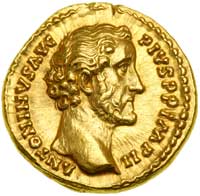 |
Antoninus Pius, AD 138-161. Gold Aureus (7.5g) minted at Rome, AD 155-156. ANTONINVS AVG PIVS PP IMP II. Bare head of Pius right. Reverse: TR POT XIX COS IIII. Togate figure of the emperor standing left, holding a globe before him. Sear 4004; RIC 256b; Calicó 1674 (this coin); Biaggi 1081 (this coin). A superb specimen, well detailed and struck in high relief. An excellent depiction of Pius. Lustrous. Nearly Mint State.
Estimated Value $8,000 - 9,000.
The Hunter Collection.
View details and enlarged photos
| Realized
$16,100 |
Lot 4152 |
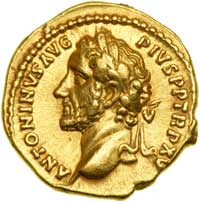 |
Antoninus Pius, AD 138-161. Gold Aureus (7.0g) minted at Rome, AD 151/152. ANTONINVS AVG PIVS PP TR P XV. Laureate head of Pius left. Reverse: CO-S IIII. Togate figure of Antoninus Pius standing left, holding a globe and scroll. Sear 4004; Calicó 1518; RIC 206; Cohen 305. Underlying luster present. Extremely Fine.
Estimated Value $5,000 - 6,000.
The Hunter Collection.
View details and enlarged photos
| Realized
$5,520 |
Lot 4153 |
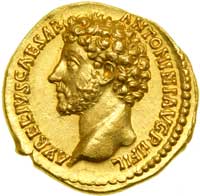 |
Marcus Aurelius, AD 161-180. Issued as Caesar under Antoninus Pius. Gold Aureus (7.4g) minted at Rome, AD 151-152. AVRELIVS CAESAR ANTONINI AVG PII FIL. Bare head of bearded Marcus Aurelius left. Reverse: CLEM, below; TR POT VI COS II. Clementia (Mercy) standing left, holding patera with outstretched hand and holding out skirt with her left hand. RIC 456c; Calicó 1815. A splendid example exhibiting underlying luster on a pleasing full flan. A superb portrait of Aurelius, struck in high relief with bold details and of fine style. Superb Extremely Fine.
The delicacy of the treatment of the portrait of the thirty-year-old Caesar Marcus Aurelius on this superb gold aureus of AD 151/2 well illustrates the heights to which the Antonine die-engravers could sometimes rise. The elegant female figure on the reverse represents Clementia, the personification of clemency or mercy, an appropriate sentiment for the reign of the 'gentlemanly emperor' Antoninus Pius.
Estimated Value $10,000 - 13,000.
The Hunter Collection.
View details and enlarged photos
| Realized
$20,700 |
Lot 4154 |
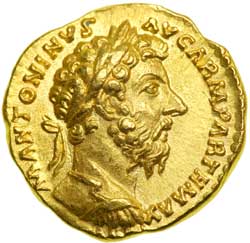 |
Marcus Aurelius, AD 161-180. Gold Aureus (7.18g) mint of Rome AD 168. Laureate and cuirassed bearded bust facing right. Reverse: Victoria (Victory) advancing left holding wreath and palm. RIC 195; Cohen 904; Calico 2009. Well struck with intense frosty mint luster. Wonderful portraiture of the philosopher Emperor. Nearly Mint State.
Estimated Value $9,000 - 10,000.
View details and enlarged photos
| Realized
$11,500 |
Lot 4155 |
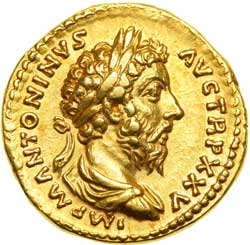 |
Marcus Aurelius, AD 161-180. Gold Aureus (7.1g) minted at Rome AD 171. Laureate, draped and curassed bust of Marcus Aurelius to right. Reverse: Marcus Aurelius, togate, standing left sacrificing over tripod-altar. RIC 250 var; Calico 2037 var; Sear 4877 var. Well struck and perfectly centered on a nice round flan. Nearly Extremely Fine.
Estimated Value $7,000 - 8,000.
View details and enlarged photos
| Realized
$8,625 |
Lot 4156 |
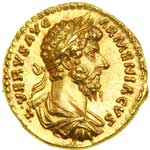 |
Lucius Verus, AD 161-169. Gold Aureus (7.3g) minted at Rome, AD 164. L VERVS AVG ARMENIACVS. Laureate, draped and cuirassed bust right of Lucius Verus. Reverse: TR P IIII IMP II COS II. Victoria (Victory) standing right, placing shield inscribed VIC / AVG atop palm tree. Sear 5338; Calicó 2177; RIC 525. Well struck, sharp and perfectly centered. Lustrous. Mint State.
Estimated Value $15,000 - 20,000.
The Hunter Collection; Ex Superior Stamp & Coin, June 2, 1992, lot 4446.
View details and enlarged photos
| Realized
$24,150 |
Lot 4157 |
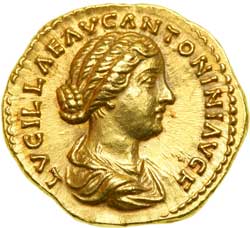 |
Lucilla, daughter of Marcus Aurelius. Gold Aureus (6.2g) minted at Rome AD 164-6. Draped bust of Lucilla right. Reverse: Venus standing left, holding apple and scepter. RIC 783; Calico 2218; Sear 5477. Well struck in high relief and delicately toned. Lustrous. Superb Extremely Fine.
Estimated Value $8,000 - 9,000.
View details and enlarged photos
| Realized
$25,300 |
Lot 4158 |
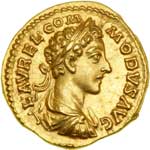 |
Commodus, AD 177-192. Gold Aureus (7.3g) minted at Rome, AD 178, with Marcus Aurelius, AD 161-180. L AVREL COM - MODVS AVG. Laureate, draped and cuirassed bust right of young Commodus. Reverse: TR P III IM - P II COS P. Castor standing left, beside horse standing left, holding bridle in right hand, scepter in left. Sear 5611; Calicó 2337; RIC 648. Wonderful youthful portrait. Lustrous. Superb Extremely Fine.
The unworthy son of a most noble father, Commodus disgraced the imperial office over a period of twelve years following the death of Marcus Aurelius in AD 180. This early aureus, showing him as a seventeen-year-old youth, belongs to the period during which he shared the throne with his father (AD 177-180).
The reverse type is of great interest. It depicts Castor, one of the twin sons of Jupiter and Leda known as the Dioscuri, the other brother being Pollux. Their cult was very important in Rome from early Republican times, and a major temple in their honor was erected in the Roman Forum. Although prominent on the Republican coinage, the Dioscuri were seldom depicted in Imperial times. The appearance of Castor on this beautiful aureus type appears to be connected with the role of the Dioscuri as the patrons of the equites, or knights, and thus the protector of the young emperor who was the leader of Rome's youth.
Estimated Value $20,000 - 25,000.
The Hunter Collection; Ex British Museum, duplicate acquired in the 1980s.
View details and enlarged photos
| Realized
$33,350 |
Lot 4159 |
 |
Commodus, AD 177-192. Gold Aureus (7.2g) minted at Rome, AD 188. M COMM ANT P FEL AVG BRIT. Laureate, draped and cuirassed bust right of bearded mature Commodus. Reverse: P M TR P XIII IMP VIII COS V P. Aequitas (Fairness) standing left, holding scales in right hand, cornucopiae in left. Sear 5601; Calicó 2306; RIC 164. A superb example, boldly struck and lustrous. Nearly Mint State.
Estimated Value $20,000 - 25,000.
The Hunter Collection.
View details and enlarged photos
| Realized
$50,600 |
Lot 4160 |
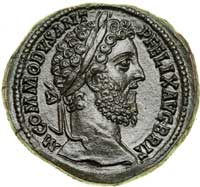 |
Commodus, AD 177-192. AE Sestertius (30.3g) minted at Rome, AD 188. M COMMODVS ANT P FELIX AVG BRIT. Laureate head of Commodus right. Reverse: FOR RED in exergue; P M TR P XIII IMP VIII COS V P P S C. Fortuna seated left; left hand holding cornucopiae; right hand holding a rudder set on globe. Sear 5746; RIC 513; BMC 618; Banti 73. Lovely uniform dark green patina with reddish-brown highlights. Well struck on a medallic flan. A fantastic example and the finest specimen we have seen. Extremely Fine.
Estimated Value $10,000 - 13,000.
The Hunter Collection; Ex Superior Stamp & Coin, NYINC Sale, December 8-9, 1995, lot 933; Tkalec 28 (Zurich), October 1994, lot 227.
View details and enlarged photos
| Realized
$35,650 |
Lot 4161 |
 |
Pertinax, AD 193. Gold Aureus (7.1g) minted at Rome, AD 193. IMP CAES P HELV PERTIN AVG. Laureate, bearded head right of Pertinax. Reverse: LAETITIA TEMPOR COS II. Laetitia (Joy) standing left, holding wreath in right hand, scepter in left. Sear 6033; Calicó 2383; RIC 4a. Boldly struck and perfectly centered. Extremely rare. Extremely Fine.
The murder of Commodus on the night of December 31, AD 192, brought to a violent end the Antonine dynasty that had served the Empire so well for more than four decades under the emperors Antoninus Pius and Marcus Aurelius. As on the occasion of Domitian's assassination almost a century before, the power vacuum was filled by a worthy successor, in this case the city prefect Publius Helvius Pertinax, a former governor of Britain. In a reaction against the excesses of the reign of his predecessor Commodus, Pertinax attempted to implement vital reforms and economies. Unfortunately, this made him highly unpopular with the soldiers of the praetorian guard who had been pampered under the previous regime. Just three months after the elevation of Pertinax to the throne, the imperial palace was invaded by a band of mutinous praetorians who proceeded to murder the emperor. A disgraceful episode ensued in which the Empire was auctioned by the soldiers to the highest bidder, thus bringing to the throne Marcus Didius Julianus. Not surprisingly, this led to outrage in the provinces where three governors vowed to avenge the murder of Pertinax by punishing the praetorian guard. Of these, Septimius Severus was ultimately successful in taking possession of the capital, ascending the imperial throne, and establishing a new dynasty that was to last for four decades. The murdered emperor was deified and his memory honored by the production of a commemorative coinage. Severus even added the name of Pertinax to his own titles. The three-month coinage of Pertinax is inevitably rare, especially so the gold aurei of which this is a splendid example.
Estimated Value $30,000 - 40,000.
The Hunter Collection.
View details and enlarged photos
| Realized
$40,250 |
Lot 4162 |
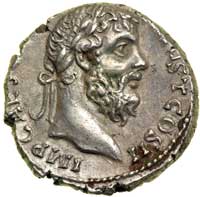 |
Pescennius Niger, AD 193-194. Silver Denarius (3.3g) minted at Antioch. Laureate head of Niger right with neatly cropped beard. Reverse: Apollo standing left, legs crossed, one hand on hip the other resting on a column and holding a laurel branch. RIC 3c var. Unusually fine medal with a bold, pleasing portrait. Very rare this choice. Some earthen deposits on lower obverse edge. Extremely Fine.
Estimated Value $5,000 - 6,000.
Ex Wolfen Family Foundation, purchased from Numismatic Fine Arts early 1970s.
View details and enlarged photos
| Realized
$10,063 |
Lot 4163 |
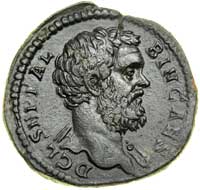 |
Clodius Albinus, as Caesar, AD 193-195. AE Sestertius (27.0g) minted at Rome, AD 194-195. D CL SEPT AL - BIN CAES. Bare head of Albinus right with slight drapery on left shoulder. Reverse: FORT REDVCI COS II S C. Fortuna seated left, right hand holding rudder on globe, left holding cornucopiae; beneath seat, wheel. Sear 6150; RIC 53b; BMC 533var; Cohen 33; Banti 11. Minor flan crack noted at one o'clock. Uniform dark greenish-brown patina. Very pleasing portrait. Very rare. One of the finer examples extant. Choice Very Fine/About Very Fine.
Estimated Value $5,000 - 6,000.
The Hunter Collection; Ex Superior Stamp & Coin, NYINC Sale, December 8-9, 1995, lot 936.
View details and enlarged photos
| Realized
$2,990 |
Lot 4164 |
 |
Septimius Severus, AD 193-211. Gold Aureus (7.2g) minted at Rome, AD 197. Laureate, draped and cuirassed bust of Severus right. Reverse: LIBERO PATRI. Bacchus (Liber) standing slightly right, head turned left, crowning himself, and holding a thyrsus; behind him at his feet, a leopard prances left, head back. Sear 6212; Calicó 2482 (this coin); Biaggi 1081 (this coin); cf. RIC 99 (obverse portrait). Crisp details throughout with underlying luster present. Very rare. Extremely Fine.
This rare and beautiful aureus type datable to AD 197 features on the reverse a figure of Liber, the name by which the Romans usually referred to the god Dionysus. Here he rests on his usual attribute, a thyrsus, a staff surmounted by a pinecone and wreathed with tendrils of vine or ivy; his attendant panther is shown at his feet. Liber was one of the guardian deities of Lepcis Magna, the birthplace of Septimius Severus, so it was highly appropriate to accord him the title of Pater (Father).
Estimated Value $9,000 - 12,000.
The Hunter Collection.
View details and enlarged photos
| Realized
$28,750 |
Lot 4165 |
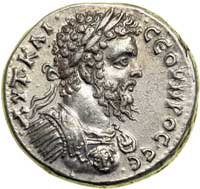 |
Septimius Severus, AD 193-211. Silver Tetradrachm (14.4g). Minted at Laodicea ad Mare, ca. AD 208-209. Laureate bust of Severus right wearing cuirass with aegis and trabea, seen from front; on left shoulder, paludamentum. Reverse: Eagle with wings spread, head left; star between legs of eagle. Prieur 1151. Very rare type. Lustrous. Extremely Fine.
Estimated Value $2,000 - 2,500.
View details and enlarged photos
| Unsold |
Lot 4166 |
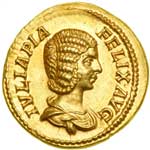 |
Julia Domna, wife of Septimius Severus. Gold Aureus (7.4g) minted at Rome, AD 211. IVLIA PIA FELIX AVG. Bare-headed, draped bust of Julia Domna right. Reverse: MAT AVGG MAT SEN M PATR. Julia Domna enthroned left, holding branch in right hand, scepter in left. Sear 7091; Calicó 2624; RIC 381. Well struck in high relief and lovely style. Superb Extremely Fine.
The extraordinary political influence of the empress Julia Domna in the period following the death of her husband Septimius Severus in AD 211 is strongly emphasized on this rare and attractive aureus type. The reverse inscription proclaims her as "Mother of the Emperors [Caracalla and Geta], Mother of the Senate, and Mother of her Country." No other empress ever bore such honorifics, and they bear testimony to the fact that from AD 211 to the time of her suicide in AD 217, Julia Domna was running the imperial government, especially during the absences on campaign of her elder son Caracalla. Her life at this time became increasingly tragic, as she was obliged to witness the fratricidal murder of her younger son Geta and the growing megalomania of Caracalla, culminating in his assassination in the East in AD 217.
Estimated Value $15,000 - 20,000.
The Hunter Collection.
View details and enlarged photos
| Realized
$41,400 |
Lot 4167 |
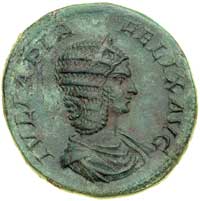 |
Julia Domna, wife of Septimius Severus. AE Sestertius (23.9g) minted at Rome, AD 211-215. IVLIA PIA FELIX AVG. Diademed and draped bust of Julia Domna right, her hair in an elaborate coiffure. Reverse: IVNO-NEM S C. Juno standing left, holding patera in right hand, resting left on scepter; peacock before at her feet. Sear 7114; RIC 585 (Caracalla); BMC 206; Cohen 88. Untouched apple-green patina with faint reddish highlights. Sharp portrait. Rare, particularly so in this fine state of preservation. Extremely Fine.
Estimated Value $5,000 - 7,000.
The Hunter Collection; Ex Superior Stamp & Coin, NYINC Sale, December 8-9. 1995, lot 940.
View details and enlarged photos
| Realized
$3,795 |
Lot 4168 |
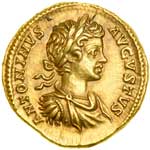 |
Caracalla and Geta. Gold Aureus (7.1g) minted at Rome, AD 199-200. ANTONINVS AVGVSTVS. Laureate, draped and cuirassed bust right of young Caracalla. Reverse: P SEPT GETA CAES PONT. Bare-headed, draped and cuirassed bust right of young Geta. Calicó 2862; RIC 38. Both portraits boldly struck in high relief with lovely 'Boscoreale' rose color toning. Extremely Fine.
An attractive feature of the coinage of the early Severan period is the dynastic series comprising gold aurei, silver denarii, and Alexandrian billon tetradrachms. There are more than thirty recorded types featuring different members of the imperial family in various portrait combinations. The majority were issued in AD 201 with a few types preceding or following the main group. This attractive aureus of AD 201 has portraits of the two sons of Septimius Severus and Julia Domna. The thirteen-year-old Caracalla already bears the senior imperial rank of Augustus to which he had been elevated three years before, while the twelve-year-old Geta has the junior title of Caesar. The age difference appears greater in the portraits with Geta looking more like a child. It is unclear why the younger brother had to wait until he was twenty before being advanced to the rank of Augustus when his elder brother had been only half that age. Whatever the reason, it was clearly a serious error of judgment on the part of Severus as it created a bitter rivalry between the two which eventually led to the murder of Geta at his brother's instigation less than a year after their father's death.
Estimated Value $25,000 - 30,000.
The Hunter Collection; Ex Hess-Leu, April 1969, lot 311. From the Boscoreale hoard of 1895.
View details and enlarged photos
| Realized
$86,250 |
Lot 4169 |
 |
Caracalla, AD 198-217. Gold Aureus (7.3g) minted at Rome, AD 207. ANTONINVS PIVS AVG. Laureate bust right of young Caracalla. Reverse: RESTITVTOR VRBIS. Roma seated left, holding Palladium (Minerva) in right hand, spear in left; shield resting against side of throne. Sear 6746; Calicó 2808; RIC 167. Well struck and glittering with luster. A superb example. Nearly Mint State.
Estimated Value $20,000 - 25,000.
The Hunter Collection.
View details and enlarged photos
| Realized
$44,850 |
Lot 4170 |
 |
Caracalla, AD 198-217. Gold Aureus (6.57g) minted at Rome, AD 217. Laureate, draped and cuirassed bust of Caracalla right. Reverse: Jupiter standing left holding a thunderbolt and scepter. Cf. RIC 285b and Calicó 2755 (bust not draped). A few minor reverse edge scuffs. Well struck and nicely toned. Excellent portraiture with underlying luster. Extremely Fine.
Estimated Value $10,000 - 13,000.
View details and enlarged photos
| Realized
$9,488 |
Lot 4171 |
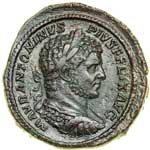 |
Caracalla, AD 198-217. AE Sestertius (32.30g) minted at Rome, AD 213. M AVR ANTONINVS PIVS FELIX AVG. Laureate and cuirassed bust right of bearded Caracalla. Reverse: P M TR P XVI IMP II, around; below Circus, COS IIII P P; in exergue, S C. View of a chariot race in the Circus Maximus, showing a long arcade flanked by monumental arches in the foreground, the central spina and obelisk, turning-posts at both ends, and the shrine of Sol in the background. RIC 500c; C. 237; cf. Sear 6929 (obverse legend). An extremely rare obverse variety of this famous reverse type. Pleasing uniform chocolate brown patina. Struck on a medallic flan. Nearly Extremely Fine.
The Circus Maximus, Rome's great chariot-racing arena adjoining the Palatine Hill, dates back to the fourth century BC. The wooden seating surrounding the track was frequently consumed by fire during the Julio-Claudian and Flavian periods, and Trajan undertook a major restoration of the structure early in the second century AD. This was commemorated on the coinage, thus providing the first detailed representation of the building. A similar view appears on aurei and sestertii of Caracalla issued in AD 213 following a further restoration.
The great central obelisk is clearly visible as are various other details of the interior, including several charioteers racing around the track. Brought from Heliopolis in Egypt by Augustus, this obelisk of Rameses II now stands in the middle of Rome's Piazza del Popolo. Constantine the Great undertook the final refurbishment of the building, and the last recorded event in the Circus took place under the Ostrogothic king Totila in AD 550 (cf. Hill, The Monuments of Ancient Rome as Coin Types, pp. 47-8).
Estimated Value $15,000 - 20,000.
The Hunter Collection; Ex Leu-Hess "ESR" Sale, 23 March 1961, lot 265; Trau Auction, Vienna 1935, lot 2277.
View details and enlarged photos
| Realized
$11,500 |
Lot 4172 |
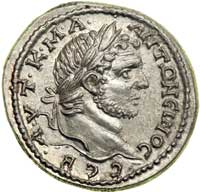 |
Caracalla, AD 198-217. Silver Tetradrachm (12.9g) struck at Akko Ptolemais ca. AD 215-217. Laureate head of Caracalla right. Reverse: Eagle, seen from front, with head left and wings spread; between legs caps of the Dioscuri surmounted by stars. Prieur 1224. A marvelous example, medallic in appearance. Lightly toned and lustrous. Probably the finest example extant. Mint State.
Estimated Value $1,500 - 2,000.
View details and enlarged photos
| Realized
$3,450 |
Lot 4173 |
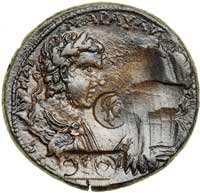 |
Caracalla and (Geta), 198-217 AD. AE 35 Medallion (19.47g) minted at Stratoniceia in Caria. Laureate, draped and cuirassed bust of Caracalla right, confronting erased bust of Geta; between, two countermarks: a helmeted head of Athena, and a stamp with four letters. Reverse: Hekate standing facing, head left, holding patera in right hand, torch in her left; dog at her feet. SNG v. Aulock 2686 (this coin); cf. BMC 69; cf Lindgren 668. Sharp types with attractive deep chestnut patina. Rare and of historical importance. Choice Very Fine.
With the death of Septimius Severus on February 4, AD 211, brothers Caracalla and Geta became locked in a deadly struggle for supremacy. The growing popularity of Geta hastened Caracalla's hand. He set a trap for his brother, and had him murdered in late December AD 211. Caracalla then immediately slaughtered Geta's supporters, some 20,000 in all, and subjected Geta to damnatio memoriae (damnation of his memory).
These events are echoed here in this medallion. The great majority of Stratoniceian Caracalla-Geta bronze medallions have Geta's portrait chiseled away. These medallions were recalled, quite possibly by temple authorities, and two countermarks were applied before the defacement was done. From the evidence of these medallions, we see that even in the East, news of Geta's murder traveled quickly, and the new political landscape, one in which Caracalla's wish was the erasure of his brother's memory, was acted upon with the same alacrity.
Estimated Value $2,500 - 3,000.
The Hunter Collection; Ex Superior Stamp & Coin NYINC Auction, December 10-11, 1993, lot 1944.
View details and enlarged photos
| Realized
$1,898 |
|
|